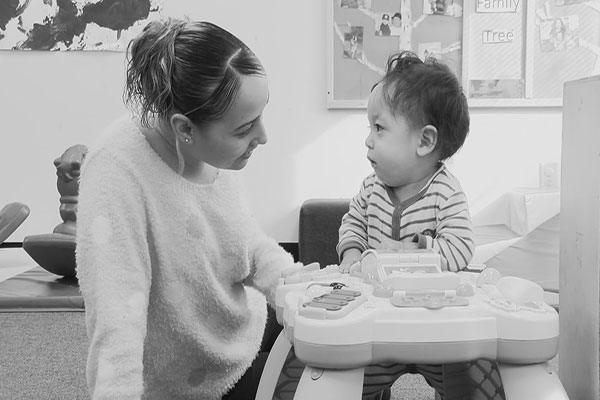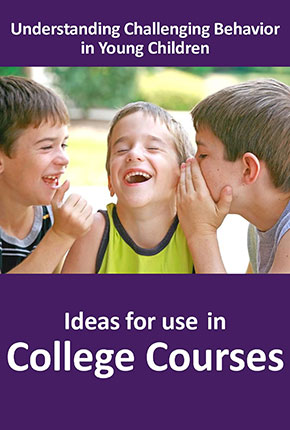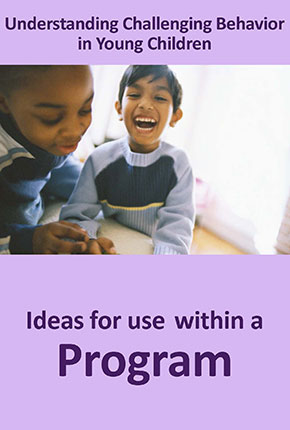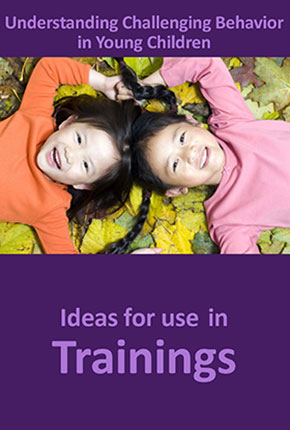Transcript for Understanding Challenging Behavior in Young Children
Anne Giordano, Education Consultant, Education Connection: Whenever young children have behavioral concerns, it’s upsetting for everyone. Sometimes we can get wrapped up in wanting to just stop that behavior rather than thinking about the root cause of the behavior. And really, if we stop there, it’s a missed opportunity. I think that’s a great reason to sort of want to slow down a little bit and think back to, “Why might this be happening?”
Understanding Challenging Behavior in Young Children (0:35)
Mary Watson Avery, Aspire Institute at Wheelock College: All behavior is communication. And no matter whether a child is showing you positive behavior – what you perceive to be as positive behavior or you perceive as challenging behavior – the child’s telling you something. Can we guess what that child is trying to tell you?
Toddler teacher: Hi Robbie. He’s excited to see you. Oops. Is that in your way? Should I move it? Couldn’t see Robbie?
Kara Wanzer, Solid Ground: Danbury Public Schools: We just have to figure out what they’re communicating and what function or what need is unmet for the child. Once we understand the child more in their circumstance, we start to see it a little differently, and then we can really work on what the student or child needs.
Cathy Tormey, Home Child Care Provider, Cathy Cares: I would consider whether the child’s coming off of a busy weekend. Whether the child’s coming off – if the behavior has all of the sudden changed. Has the child been sick? Are there changes going on in the family? I would ask if anything’s different or special happened. One of the kids recently had a pretty serious fall, and so now, she’s frightened of going down the stairs. If I didn’t have that information, I wouldn’t be able to figure that out.
Jamie Vallarelli, Kindergarten Teacher, Natchaug Elementary School: When a child is really starting to push my buttons, I really try to take deep breaths. And I try to get to the bottom of the problem right away and try to get to what’s really bothering the child and help them work through it, rather than just implementing a consequence right away.
Janette Rivera, Infant/Toddler Teacher, Windham Early Head Start: One of the things as a teacher that I do is observing the child. Why is she doing this? You know, taking notes on what happened before, what happened after, and how can you get that child to communicate her needs? It’s very important to understand where she’s coming from, too.
Kara Wanzer: One thing I ask teachers to keep in mind all of the time is to be reflective in their relationships that they have with parents and with children. That’s the first thing that we need to think of as teachers when we enter a classroom. We’re also in a relationship with that child, so they’re learning how to go about doing the right thing or what’s a really good prosocial skill to have, by just being in a relationship with you.
Factors that Influence Children’s Behavior: Medical, Physical, and Sensory Needs (2:58)
Anne Giordano: I think whenever we’re looking at the behavior of very young children, certainly we want to always look at medical types of things and rule that out. Is there something medical or is there something physical that might be impacting that child? Is the child hearing adequately?
Dr. Ann Gruenberg, Professor of Early Childhood Special Education, Eastern Connecticut State University: Sometimes children have sensory differences that can affect how they behave, and they don’t always have deep-seated emotional issues associated with those.
Dr. Tanya Moorehead, Professor of Special Education, Eastern Connecticut State University: If students are overstimulated, they might retreat, and their behaviors might be interpreted by the teachers as there’s something wrong with them. And in turn if a student is understimulated, they might jump around, make a lot of noise, because they’re trying to meet that need of being stimulated.
Ann Gruenberg: And there’s a lot of good information about children with patterns of language delays sometimes having behavioral issues, because they’re perpetually not able to express what they want or what they need using words.
Developmental Stage (4:09)
Michelle Levy, Education Consultant, Office of Early Childhood: Sometimes the stages of development may involve behaviors that seem inappropriate or out of line, but may actually be a natural phase that children go through.
Anne Giordano: Very young infants have a job of establishing security and safety, so they are going to cry. That’s their only tool that they have to let you know that they need you. A more mobile infant is going to do a lot of exploring and starting to get into trouble. But we need to remember that that’s what they’re supposed to do at that age.
Michelle Levy: Toddlers often begin to assert themselves by saying, “No,” over and over again, and that’s one of the ways in which they assert themselves.
Maureen Ostroff, Preschool Teacher, CES School Readiness Program: I would never get through a book if I waited for everybody to sit down and not sit, “Crisscross-applesauce, hands in your lap.” And you can’t get 18 adults to do everything the same way at one time, let alone 18 three- and four-year-olds. If you look at the standards, it’s not an expectation for all 18 kids to sit there like this, and just look at a story.
Maureen (reading): Once upon a time, there was a little old man and a little old woman. How’d they feel? Do you remember?
Maureen Ostroff: They’re not all going to sit, and this is why we do two small groups also for the story. And it’s okay if they’re touching the book during all that time, and they can grab the book from me. It’s alright; it’s just part of being three and four.
Michelle Levy: I think having adults be able to look at the early learning standards, consider what is typical in the development of these various skills, can really provide a useful tool for both understanding child development and where things may be out of step.
Individual Differences and Temperament (5:49)
Anne Giordano: We always need to be thinking about what might be a uniqueness that a particular child might be bringing. Some children are very auditory learners. Some children are very kinesthetic learners.
Child: A bunny, like this! Hop! Hop! Hop!
Janette Rivera: Every child is unique, and as a teacher, we all need to adjust. Step back and think about the child, through observation, through play. Whether they’re shy, or they’re more opened up.
Child: I'm trying to be the doctor here. Okay? I'm trying to save the baby. You can be the nurse, okay? Be the nurse. You want to be the nurse?
Ruth Ettenberg Freeman, CT Positive Parenting: Most people think that their experience is what everyone’s feeling. So if you like physical contact, you give a lot of physical contact, and they might be trying to get space. They may be getting too much stimulation. You have to understand that your way of being in the world is relative.
Family Culture (6:53)
Tanya Moorehead: How the family interacts with their child is very important. I think that’s when you find out about family culture. One child might be able to run around freely and explore their environment, while the other one was taught to sit still and only move when an adult gives them permission to move. So if you have both within your classroom, and you have one child exploring, and the other child who’s timid or appears to be timid, it is not that one is not learning and one that is misbehaving, it’s that they’ve been taught differently within their households.
Yotisse Williams, Preschool Teacher, Housatonic Community College Early Childhood Lab School: Cultural influences are a very big part of, I would say, the child’s development. In our classroom, we really encourage self-help skills, and there’s one little guy I’m thinking of in particular, Dad does everything for him at home, and it’s a cultural thing, you know, Mom has shared with me. But the thing about that is, when you have an environment that’s conducive to parents sharing, then you have an understanding of what those cultural influences are and how to support them. Also, how to get the parents to see what you’re trying to do. We have to back up a little bit and get to know the parents.
Anne Giordano: Every home brings its own culture. What we can do is be up front about that and say, “Tell me a little bit more about your home when it comes to sleeping and eating.” We need to learn about what the family routines are so that we can understand them and then partner with families to say, “Well, let’s work together on how we might be able to help your child master a new skill here.”
Classroom and Home Environment (8:50)
Anne Giordano: Children’s external environment has a large impact on how they’re able to manage themselves. Highly distractible children are going to have a really hard time maintaining focus and attention and staying on task if they’re constantly bombarded with sound and activity. I think sometimes it’s a really good practice for teachers to maybe just sit on the floor and just look around and listen. One sort of general rule of thumb is that if you have many children exhibiting the same behavior in a space, you might say to yourself, “Huh, I wonder whether we need to look at this environment?” You know, if someone’s biting in the block corner, perhaps it’s too tight of an area, and we’ve got too many children congregated there. We also can think about whether, do we have too much space? So, do we have children running all over and banging into one another?
Ashley Anderson, Preschool Teacher, Plainfield Head Start: To me, having an environment that is calm and safe and free of run spaces so no one’s doing laps in the room—it really affects their behavior. I strive to have as many natural fibers and materials in my classroom as possible to lighten the mood and to bring it down to a calming level. Soft music playing during meal times. And so making sure that we are aware of what their environment at home is like, and then adjusting our classroom environment.
Anne Giordano: If the child has had a lot change in their environment at home, maybe there’s been a disruption in where they’re living, maybe there’s been a family separation. Well they’re then having to function in environments with different expectations, and that’s a lot for a little one to learn the rules in all of those places. And while we’re not going to change those things, we need to kind of know about that.
Pat Kitchen, Pat’s House Family Child Care: They just go with the flow and know that they need some positive reinforcement – everything’s going to be okay. And they’re not verbalizing it and trying to talk about it, but you know that’s affecting the behavior.
Learning New Behaviors (10:58)
Anne Giordano: Children can only do what they know, right? They just haven’t learned new things yet. So, it’s our role as teachers, and parents, and caregivers to teach those new things, new skills for them and give them plenty of time to practice them. And we have to be patient and remember that they are learning.
Toddler teacher: Oh no. Stop. How are we using these balls? How should we use them? Can you feel how hard this is? Touch it with your fingernail. Touch. What would happen if this hit a friend? What would happen if you threw it, and it bumped a friend? Ouch! That would make a big boo-boo. We’re going to roll the balls; you may roll the balls.
Cathy Tormey: We do a lot of talking when there is inappropriate behavior. I address that, and I’ll say, “No, that’s not nice. Hitting hurts,” or “You took this away, and now she’s sad.”
Child: Me.
Cathy: Wait a minute; ask. You have to use your words. Ask Lexi.
Child: May I have please? Oh, thank you!
Cathy: See? She shared with you.
Mary Watson Avery: Behavior is one of those things that adults think children should just kind of learn or pick up on their own. I ask teachers to think of it as, “Would you expect them to learn how to read on their own?” “If I want them to act this way, do they have the skills to do it? And if they don’t, how can I teach them, how can I support them to have it? How can I remind them of what to do?”
Preschool teacher: Dustin, he doesn’t know what you want to say unless you use your words. What would you like to tell him? What would you like to tell him with your words?
Child: Please don’t do that.
Significant Emotional Needs (12:54)
Anne Giordano: All children from their earliest days learn how to regulate, learn how to feel safe, learn how to function based upon the very earliest attachment relationships that they’ve had. But we also know that not all of our children have had that good fortune. We have children who’ve experienced trauma; we’ve had children that have had disruptions in their home life. We’ve had children that are experiencing toxic stress all around them in their family lives. And we have to remember that those children are going to come with us with really strong needs. And usually those are the behaviors that are the hardest to manage, and they need us the most. But then what we have to do is remember that that child is asking for our help, and really what they’re saying is that, “I feel unsafe,” and “I feel insecure.”
Kara Wanzer: It might not be something that we can have control over, but we do have control over helping them build more skill in emotional literacy, in pro-social behaviors, and things like that. There are times where it’s really important when we’re working with kids who really have a challenging behavior—so we’re talking persistent, over-time, that’s interfering with their social relationships, or their learning. And for those kids, they need a team.
Anne Giordano: These are times that we often need to think about what other referrals might be appropriate to support that child, because it may be bigger than what we can remediate within a center environment or in a caregiving environment. And we can work in tandem then, so that we are all working on the same goals and using the same strategies.
Kara Wanzer: It’s really important that we see the whole context of the situation and the whole child—what the situation is for a child; what their temperament is; what their environment is; what their home life is. What are this child’s strengths? And then how can we build on what the child already has?
Anne Giordano: If we understand the root cause, and it takes some work to figure it out, but if we can understand that, it gives us an opportunity to teach. And that’s really what we want to do, is use as a learning point for children to grow from, because much of it is practice and learning. We have to teach them.
© 2015 Center for Early Childhood Education at Eastern Connecticut State University
May be reprinted for educational purposes.






